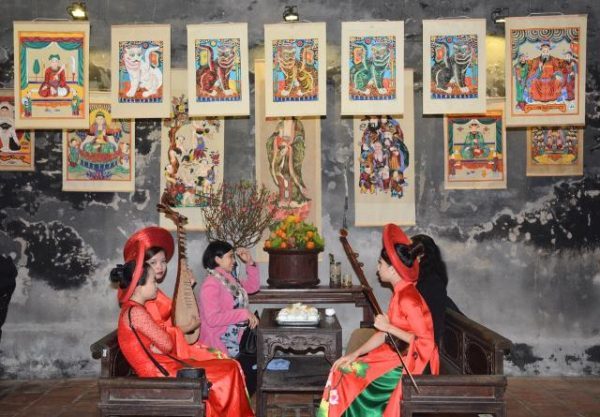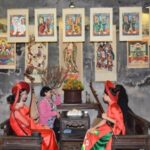At one time, Hang Trong folk paintings were famous. Now, artisan Le Dinh Nghien, the only remaining one of Hang Trong folk painting line, is still working on his craft to preserve and inherit to the next generations.
The painting “Carp Looking at the Moon” is being created by the talented artisan Le Dinh Nghien. (Hoa An’s picture)
Early 20th century is considered the flourishing period of Hang Trong folk paintings. At that time, although many families in Hang Non, Hang Quat, Hang Son … also made paintings but it is called Hang Trong paintings mainly because they were produced in this Street.

The painting “Carp Looking at the Moon” is being created by the talented artisan Le Dinh Nghien
Hang Trong paintings had two main lines of worship paintings and Tet paintings. According to many researchers, Hang Trong paintings derived from religious paintings, as a result of the elite interplay between Buddhism and Confucianism; between the types of worship and sculpture statues in the temples and beautiful features in daily cultural activities. Hang Trong paintings are featured with the very slender and refined line, fresh and lively colors and generous form. Made of warm and yellow Do paper, the longer the period of maintaining and keeping the paintings, the more ancient they are.
Hang Trong paintings are famous with the lines of “Fu Lu Shu”, “Seven Kids”, “Forever family”; comic books and funny pictures such as “Mouse’s glory”, “Toad scholar”, “Kieu story”; pictures of activities and nature such as “Countryside marketplace”, “Agricultural activities”, “Peacock”, “Carp Looking at the Moon”, “Treasurous Four”, “Four beatiful girls”…
However, now, only artisan Le Dinh Nghien pursues and keeps the craft of Hang Trong folk paintings. He also keeps the technique of making pictures according to ancient engravings from previous century

Hang Trong painting is being exhibited at Kim Ngan temple, Hang Bac street, Hanoi.
Hang Trong paintings are printed with wood engraving on paper, then the painters use pens to paint each piece of light and dark color, depending on the content, lines and types of paintings. The next stage of backing is an important stage in the process of forming a work. According to artisan Le Dinh Nghien, the success and durable existence of the works depends on this stage because the stage requires skillfulness. Because of coloring manually, each picture shows the creative feature of the artisan.
The people fond of folk painting still go to Cua Dong Street to meet the only remaining artisan. Artisan Le Dinh Nghien belongs to the third generation of a family of painting craft in Binh Vong village, Thuong Tin (former Ha Tay province) but lives and works in Hang Trong street (Hanoi). Different from his 7 brothers and sisters, only he has followed the family’s craft.
According to artisan Le Dinh Nghien, at one time, Hang Trong paintings were made year-round, but made more in Tet because the people bought the paintings to hang in their houses with wishes of a year of luck and harmony. The characteristics of the Hang Trong painting are suitable for all people, regardless rich or poor.
With his nearly 60-year experience in Hang Trong painting craft, artisan Le Dinh Nghien is busy all year round, not only on the occasion of Tet like the old days. Over the time, now, the Hang Trong painting is no longer bustling as before, but still has its firm position in the lines of traditional folk paintings.
The artisan told that although they were older, they are always busy because some pictures can be completed in a morning or in a day but some take two to three weeks. Especially, worship paintings must be made very carefully, for example, every detail of the Buddha’s sleeve requires the meticulousness; therefore, the artisans must retreat to show the soul and beauty of the paintings. The Do papers also requires artisans to draw each line correctly and take enough ink to prevent running and water absorption which cause the paintings to be completely broken..
Happily, although the society increasingly develops and the number of Hang Trong painting lovers is decreased, they set out the higher standard. Therefore, the artisans must pay the special attention, not produce massively but improve their techniques to make the complete folk paintings.
Mr. Le Dinh Nghien shared he is old, this career is inherited, he still works as long as he is healthy. However, when he was ill, he was anxious of succession. Although his son is the successor, but with the low number of successors, he worries that the craft is lost in oblivion.
“As I am no longer healthy, I want my chidren and grandchidren to continue to pursue this career, and preserve the wood engravings transferred from hundreds of years ago”, said he.
Hoa An

